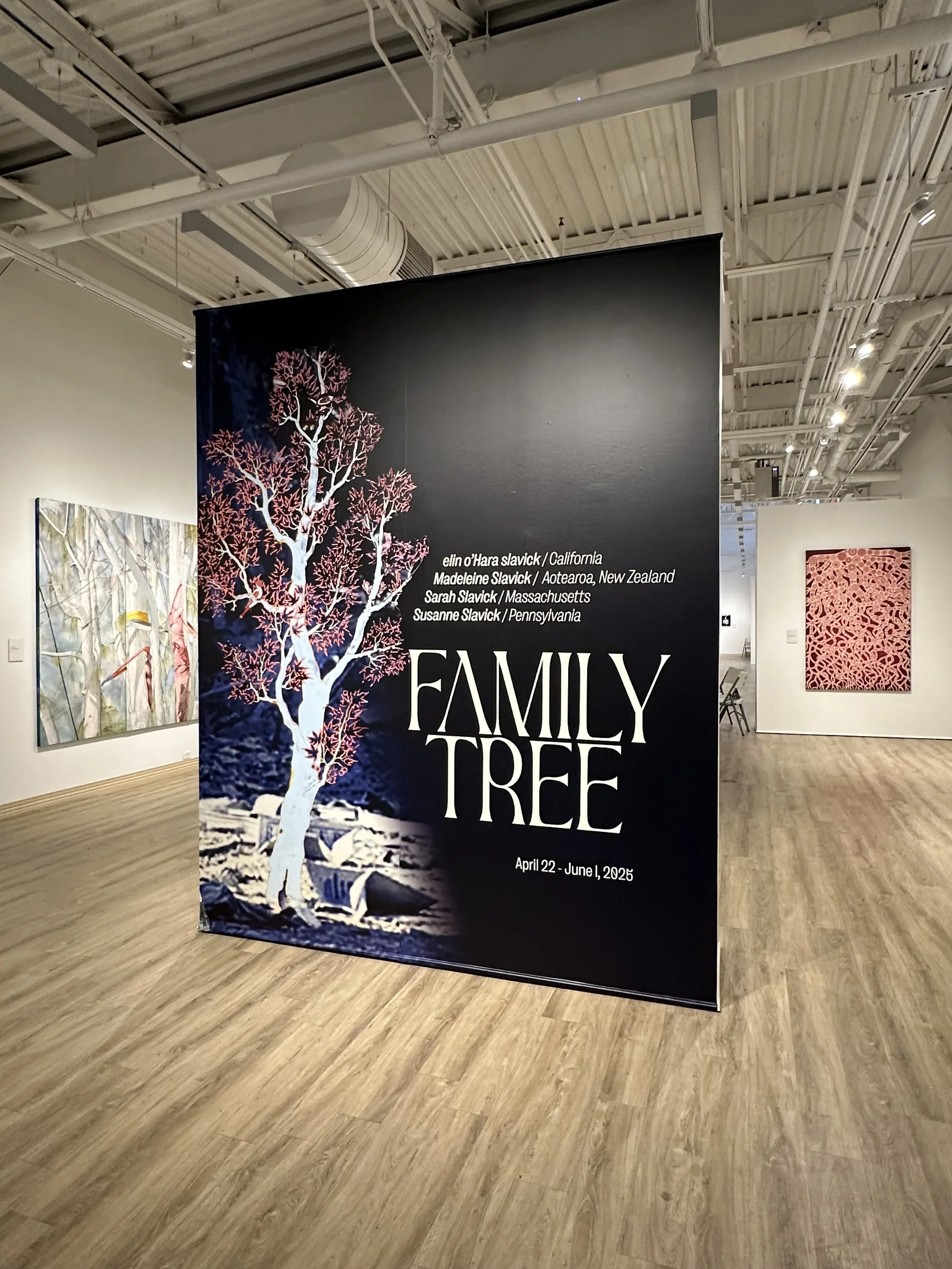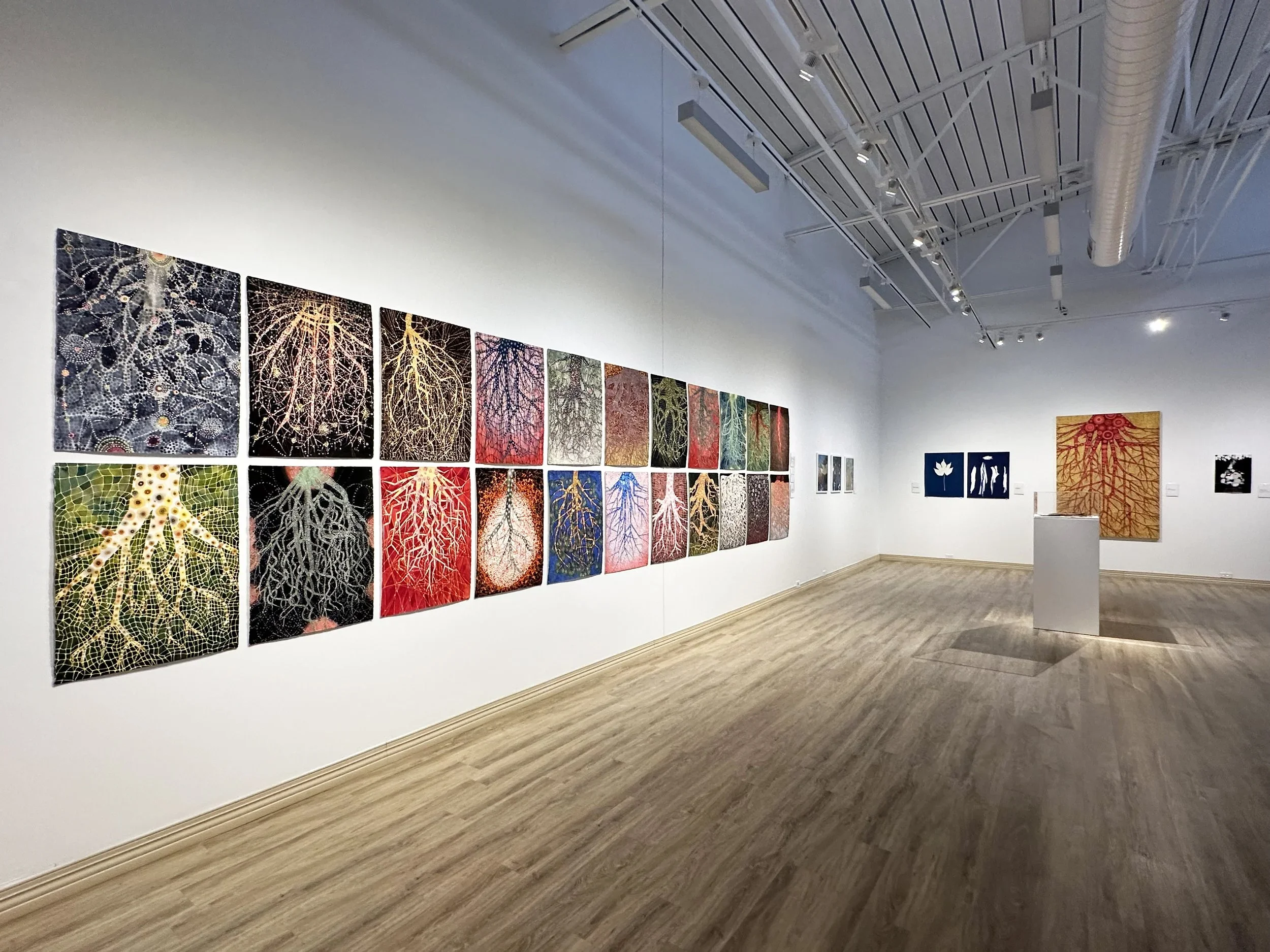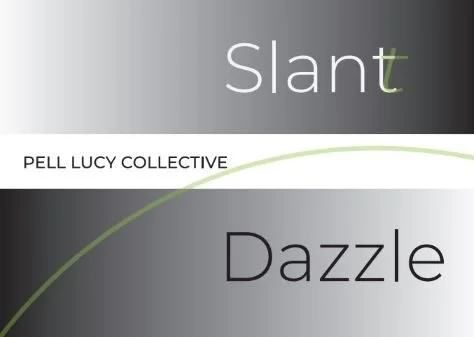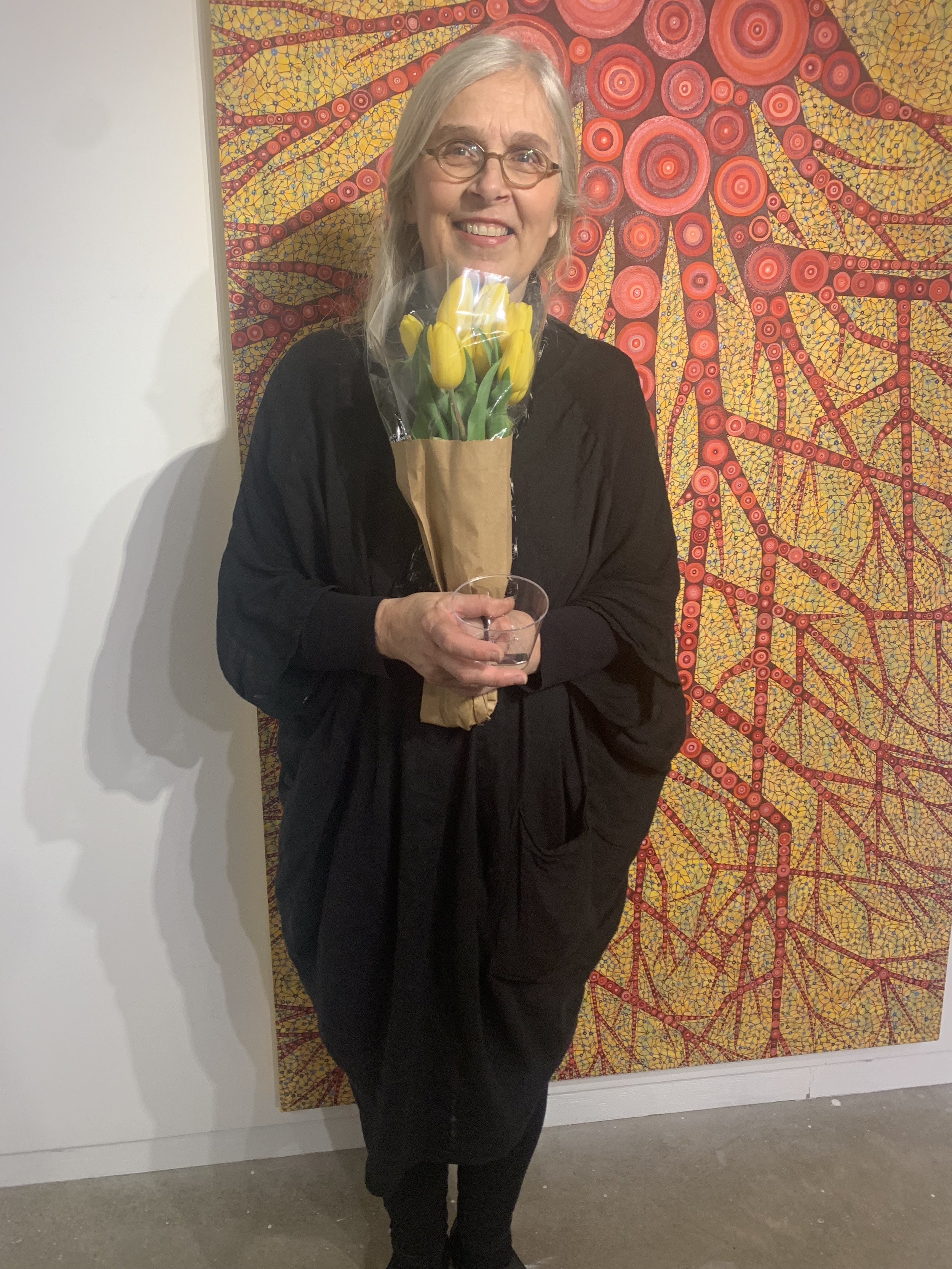Pearl Conard Art Gallery
Ohio State University, Mansfield Campus
FAMILY TREE
elin, Madeleine, Sarah and Susanne Slavick
Tuesday, September 9 – Friday, October 24, 2025
Opening reception: Tuesday, September 9, 2025, 12:30 – 1:30 pm
In a 1940 poem, Bertolt Brecht asked:
What kind of times are they, when
To talk about trees is almost a crime
Because it implies silence about so many horrors?
In a 1995 poem, Adrienne Rich answered:
…so why do I tell you
anything? Because you still listen, because in times like these
to have you listen at all, it’s necessary
to talk about trees.
Family Tree brings together the work of four sisters to ‘talk about trees.’ As curators, painters, photographers, and writers, we portray trees in in and outside of human care and conflict. In exploring the multitude of relations within and between trees and humans, genealogical roots and botanical roots intertwine.
Whether bombed or irradiated, contained or sidelined, in underground union or standing in persistence, trees and their representations can offer solace and space—for the necessity of talking, listening, and learning. Family Tree offers both critical commentary and sensual delight in visualizing the tree as refuge and livelihood, consumed and consuming, under assault and triumphant, as historical record, and as harbinger of things to come.
With thanks for support from:
The City of Boston, College of Fine Arts at Carnegie Mellon University, Hiroshima City University, Hiroshima Peace Memorial Museum, The Japan Society for the Promotion of Science, Lesley University and Masterton Creative Communities/Creative New Zealand.
FAMILY TREE AT SORDONI GALLERY
August 7, 2025
April 22 - June 1, 2025, Wilkes University, Wilkes-Barre PA
Sordoni hosts ‘Family Tree’ exhibit, featuring works by four sisters in Times Leader
Sordoni Art Gallery Hopes Latest Exhibit Helps Visitors Branch Out in News Wilkes
Omphalus 1, 2024, oil on canvas, 44” X 69.5
Bristol's Grimshaw-Gudewicz Art Gallery to open Slant Dazzle: Works by The Pell Lucy Collective on October 31
October 31 to December 13, 2024
Opening Reception
Thursday, November 7, 6 to 8 p.m.
Gallery Hours
Monday - Thursday: 10 a.m. to 4 p.m.
Friday: 10 a.m. to 1 p.m.
Pell Lucy is an international collective of artists that came together during the pandemic, under the guidance of Deborah Barlow. The name “Pell Lucy” is a thoughtful play on the word “pellucid,” which means clear or transparent. This choice reflects the group’s shared commitment to creating art that transcends the human form and speaks to something greater—something that connects us to the world beyond our immediate experience.
Although Pell Lucy artists do not set out with explicit messages or agendas, their work still makes a powerful statement—one that resonates on both a political and social level. By allowing form to speak in its own voice, they reveal truths that are often hidden from view: the profound connection we share with the cosmos and all that exists within it. Their approach to art is a way of fostering a deeper connection with the world, urging us to feel, rather than just see, our place within it.
This perspective aligns closely with Emily Dickinson’s famous poem, “Tell all the truth but tell it slant.” Dickinson’s words suggest that truth, especially when it is complex or challenging, is best revealed gradually, with care and subtlety. The idea is that truth should be shared in a way that allows people to absorb it fully, rather than overwhelming them all at once. This concept of careful, incremental revelation is echoed in Pell Lucy’s work, where the emphasis is not on direct messaging but on creating space for a deeper understanding to emerge naturally.
In the exhibition Slant Dazzle, 33 artists from the collective have chosen a piece that responds to this idea of truth revealed indirectly, as suggested by Dickinson’s poem. The result is a collection of works that invite us to reflect on the broader themes found in Dickinson’s writing. The works do not need to overtly illustrate the poem’s ideas to be meaningful; rather, they embody the same nuanced approach to truth and understanding that Dickinson herself championed. Through this exhibition, we are offered a chance to engage with these ideas in a way that is both thoughtful and profound, revealing the beauty in complexity and the power of art to touch the depths of human experience.
For more information, please visit http://www.bristolcc.edu/gallery or email Kathleen.Hancock@BristolCC.edu.
More Information at: https://bostonarts.org/event/bca-27th-drawing-show/
BOSTON, MA - Boston Center for the Arts (BCA) announces its 27th Drawing Show — Yušká: Uncoil, juriedand curated by Erin Genia. After a five-year hiatus, this highly anticipated exhibition including artworks from forty-four artists will be held at the Mills Gallery, located at 551 Tremont St, Boston, from May 11 to August 3, 2024. The opening reception will take place on Friday, May 17, 2024, from 6–9 PM, providing visitors the chance to engage with the artists and curator firsthand.
From traditional to contemporary, the exhibition celebrates the rich tradition and interrogates what defines the medium. This year’s Drawing Show is Yušká: Uncoil. In the Dakhota language, the word Yušká means: to untie, release, uncoil, loosen, set free. Its meaning can range from the simple untying of a knotted rope, all the way to a philosophical undoing of political, economic and social constructs. Curator Erin Genia elaborates:
Life is sustained by Earth and everything we do is the result of our connection to the lands we live on. This basic reality has been lost to most, but it is central to Dakota cosmology. All cultures of the world stem from Earth-based ways of living, and for the past couple centuries, those ways have been targeted for erasure and nearly destroyed by dominant societies, but we remain Earth-based beings.
Artists’ unparalleled ability to speak to the intangible gives them a singular way of addressing inequities and presenting visions of a better world. This power, alongside fluency in the creative process, can be a catalyst for social change that aligns with the Dakhota word Yušká. The crises of climate change and ecological destruction are the result of the same cultural dynamics that are intertwined with economic inequality and the injustices of racism. Beginning with Yušká, how can artists honor the agency of the Earth and our place in it? How can we devote our creative work to unraveling the immense knot formed by harmful ideologies that threaten the web of life?
Participating artists: Ryan Aasen, Constanza Alarcon Tennen, Crystal Bi, Geoffrey Booras, Kameko Branchaud, Stephanie Cardon, Darius Carter, Mayté Castillo, Woosik Choi, Leah Craig, Tanya Crane, Mark Hernandez-Motaghy, Corazon Higgins, Elizabeth James-Perry, Ashley Jin, Alex Kalil, Iwalani Kaluhiokalani, Lucien Dante Lazar, Andy Li, Patte Loper, Evangelina Macias, Robbie Moser-Saito, Marie Zack Nolan, Sheila Novak, Chris Pappan, Crater Powers, Kiara Reagan, John Ros, Mica Rose, Meg Rotzel, John Roy, Michelle Samour, Homa Sarabi, Bryan Shea, Mimi Silverstein, Susanne Slavick, Sarah Slavick, Michelle Stevens, Michael Talbot, Vivian Tran, Ananth Udupa, Margaret Inga Urîas, Jael Whitney, Adam Wise and Erin Woodbrey.
Family Tree
Family Tree at the Erie Art Museum
Opening Reception: May 24 6PM
Elegies to the Underground Series at Dowd Gallery, SUNY Cortland
elin o’Hara, Madeleine, Sarah and Susanne Slavick
USA Tour:
Sordoni Art Gallery, Wilkes University, Wilkes-Barre, PA
April 22-June 1, 2025
Martin Art Gallery, Muhlenberg College, Allentown, PA
January-March 2025
Erie Art Museum, Nichols Gallery, Erie PA
May 18-October 18, 2023
Dowd Gallery, SUNY Cortland, Cortland NY
October 24-December 2, 2022
10 min videos by the four artists
Maine Art Journal article about project
Dowd Gallery Exhibition Gallery Info
Programmed Events at Dowd Gallery scroll down here
Family Tree Whakapapa premiered at the Aratoi Wairarapa Museum of Art and History, Masterton, New Zealand, December 12 2020-February 14, 2021. The exhibit then traveled to the Wallace Arts Center, Auckland, New Zealand, April 21-June 13, 2021.
Family Tree Whakapapa Catalogue Cover
A full-colour publication accompanied the exhibition, with an essay by Katherine Guiness and a poem by Rawiri Smith.
Exhibition press release for Family Tree at Wallace Arts Center, Pat Homestead Photoforum NZ online
The term Whakapapa is a Maori term that refers to knowing who you are and where you are from, placing yourself in a wider context with links to land and community.
Luminous Elsewheres
Luminous Elsewheres at Westbeth Gallery
March 31-April 28, 2023
Westbeth Gallery, 55 Bethune St, NYC
March 31-April 28, 2023
Wednesday through Sunday, 1-6pm (And by appointment)
Opening reception: Friday March 31, 6-8pm
Closing reception: Friday, April 28, 6-8pm
My piece in the exhibit- Pulse, 2018, oil on wood, 20” X 16”
This exhibit features artists who actively explore visual domains that are evocative, mysterious and unexpected. Eschewing the confines of logic and linearity, Luminous Elsewheres artists are receptors through whom “the echoes and reflections of an irrational elsewhere flow freely and take form.” (Daniela Ferretti)
“Each artist in Luminous Elsewheres has honed a vision of a personal ‘elsewhere’ that embodies its own radiant dimensionality,” the curators have written. “These visual explorations open up new ways of seeing, feeling and perceiving.” Sourced primarily through intuition and the process of art making itself, the works included in this show bring viewers closer to what Susan Sontag described as “the luminousness of the thing in itself.”
At a time when the collective sense of the world is being disrupted, realigned and reinvented, this approach explores a more allocentric and inclusive way of seeing and feeling. Visual art contributes to constructing a better and more sustainable future, an idea captured in the words of Luminous Elsewheres artist Taney Roniger: “Here we come to the otherness within art itself: that rare kind of art that, defying ready comprehension or systematic interpretation, instead plunges the viewer into the ocean of unknowing.” That ocean of unknowing becomes the place to discover the next story, a better story.
The following artists will be featured in Luminous Elsewheres: Phoebe Adams, Tracey Adams, Cheryl Aden, Deborah Barlow, Hedwig Brouckaert, Janine Brown, Leigh Anne Chambers, Mi-Jin Chun, John Cox, Alison Cuomo, Patrician Dahlman, Silvia De Marchi, Tina Feingold, Karen Fitzgerald, Kathryn Geismar, Caroline Golden, Ed Grant, Laura Gurton, Lynette Haggard, Carole Kunstadt, M P Landis, Joanne Lefrak, Denise Manseau, Donnelly Marks, Elizabeth McAlpin, Diane McGregor, Elizabeth Mead, Elizabeth Mooney, Kellin Nelson, Paula Overbay, Heather Palecek, Sky Pape, Deborah Peeples, Laura Ann Perry, Mary Pinto, Taney Roniger, Larry Rushing, Ann Sgarlata,Julie Shapiro, Sarah Slavick, Rhonda Smith, Malu Tan, Linda Tharp, Priya Vadhyar, Debra Weisberg.
Luminous Elsewheres is curated by Deborah Barlow, Alison Cuomo and Karen Fitzgerald. Representing three international artist collectives--Pell Lucy, Fluid Media and Spliced Connector, respectively—the curators have selected work from members of these groups as well as other aligned artists. “We all share an interest in the many ways artists create extraordinary ‘elsewheres’: trusting the process, learning from materials, relying on intuition, giving voice to the innate intelligence of form,” the curators stated.
For exhibit updates and events:
Luminous Elsewheres show guide
Press contact: Deborah Barlow dbarlow@gmail.com @deborahbarlow
Pell Lucy:: In Praise of Form
Pell Lucy: In Praise of Form
Piano Craft Gallery, 793 Tremont Street, Boston MA
April 1 -24 2022
A catalogue accompanied the exhibition.
P E L L L U C Y :: I N P R A I S E O F F O R M
My catalogue page
Exhibition catalogue essay:
Over the last several decades, formalism in the visual arts has largely been considered a critical embarrassment, one more relic of a bygone era felled by misbegotten ideals. Indeed, since the rise of postmodernism in the latter half of the last century, art has become ever more discursive, prioritizing issues and ideas over the forms in which they are instantiated, often relegating the latter to the status of incidental. But with the larger cultural search for more ecologically aware ways of being, many artists are returning to form, not in the name of a new art world ism but as a means of reclaiming our continuity with nature.
Pell Lucy is a collective of just such artists. Established in 2019 under the leadership of Deborah Barlow, the group coalesced around a set of shared values, all rooted in the emerging ecological ethos. Rejecting the preoccupation with the self that has been our modern Western inheritance, Pell Lucy’s orientation is decidedly outward: away from the human subject formerly at the center of the world and toward the larger world beyond us from which we have become estranged. And for these artists it is form – sensually embodied, discursively silent form – that most powerfully conducts us in this direction. It is the language of the sensual, after all, that we share with other creatures – or, in the Native American locution, with All Our Relations.
Departing from the rigid binaries of the formal- ism of old, Pell Lucy’s pivotal belief is that form, like the body, possesses an intelligence of its own – one far more capacious than conscious, discursive thought. No longer opposed to content but a kind ofcontent of its own, form is here honored as our originary language.
Addressing itself directly to the body, form accesses the deeper regions of our bodymind that house our biological inheritance, both as animals born of the earth and as matter born of the cosmos. And because it embodies the same forces that animate all matter – its rhythms and patterns, its tensions and vibrations – form acts on these deeper levels as an agent of re-membering: bringing back into union that which has been wrest apart. Through attentive engagement with form, these artists believe, we can re-awaken to ourselves as creatures and thus recover a felt participation in the vitality of the world.
Following from the move away from human centrism is Pell Lucy’s embrace of unknowing, of mystery. In a culture that prizes certainty and mastery, much recent art has become intent on delivering messages (and with increasing stringency, those of a political nature). But for Pell Lucy, ambiguity is art’s strongest suit; serving as a kind of gateway to wonder, not- knowing can be a potent means by which those willing to make the self-surrender can profoundly experience a re-enchantment of the world. Offering sensually alluring objects that defy comprehension, these artists draw the viewer into a wilderness of otherness – but one that, while alien to the thinking mind, resonates deeply with the knowing body.
Although it eschews explicit messages or any didactic agenda, Pell Lucy’s vision is nonetheless deeply political. Indeed, withits radical embrace of form as an agent of re-membering, the group embodies a plea for unification on every level. For in reminding us of our shared inheritance with all of earth and cosmos, sensual form necessarily awakens us to our commonality with our fellow humans.
Returning us to our carnal senses and then drawing us outward, form can thus be a source of great renewal and reconnection.
While its sights are set firmly on the larger world, Pell Lucy’s ultimate challenge is to art itself. Will it continue to hold human reason as its highest value and thus remain mired in a moribund worldview? Or, infused with the spirit of a wisening culture, will it welcome back into its fold all that reason has cast out and thus help lead the way to a more integrated future? For these artists at least, the answer is as clear as the name of their group suggests.
– Taney Roniger
At the opening with flowers from students
The exhibit was reviewed by Kate McQuaid in the Boston Globe, April 14, 2022
Interalia Magazine
Interalia Magazine, Emerging Ideas Section
An online magazine dedicated to the interactions between the arts, sciences and consciousness.
Sarah Slavick: Elegy to the Underground
Excerpt-
In the book, the Hidden Life of Trees, Peter Wohlleben makes the case that the forest is a social network where trees engage in social behaviors, communicating with one another through a vast network of roots. They are not simply individual entities but part of a much larger, complex system that communicates and responds as an organism. There is a whole ecosystem that lives and thrives at the top, around, and in a tree. Through its whole life and even after it is dead and decaying, a tree supports the life around it. Through sharing resources and working together in complex and infinite pathways, alliances, and kinship networks, trees reach enormousness and increase their chances of survival and ours as well. These new discoveries of the hidden life of trees suggest new metaphors for our survival and how we should act to protect our home and our species. My Elegy to the Underground watercolors and oil paintings are a tribute or memorial to trees whose heartbreaking loss I fear and mourn.
Elegy to the Underground 14, 2020 watercolor/arches paper
……………………………………..
Sarah Slavick is a visual artist, political activist, union leader, and professor in the Fine Arts Department at Lesley University’s College of Art and Design in Cambridge, Massachusetts. Slavick’s work was described in the Boston Globe as “a kind of abstract portrait of the psyche in all its dense, unknowable layers.” While her work is abstract, she references cell biology, accretion of geological formations, botanical structure, and the taxonomy of the natural world. Much of her work is inspired from literature, women’s studies, the sciences, philosophy, and the political arena. Slavick holds an MFA from Pratt Institute and a BA from Wesleyan University.
A member of a large family, she has five siblings, three of whom are also professional artists. The current exhibition, Family Tree Whakapapa, brings together the work of four sisters to ‘talk about trees.’ As curators, painters, photographers and writers, we portray trees in conditions in and outside of human care and conflict. In December 2020, the exhibit opened at the Aratoi Museum of Art and History in Masterton, New Zealand, followed at the Wallace Arts Trust Pah Homestead in Auckland and will be exhibited at the Erie Art Museum, Erie, PA USA in January 2023.




















